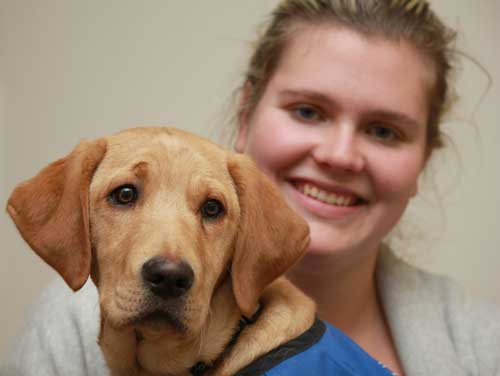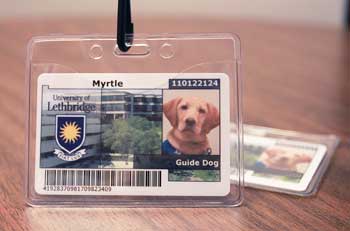The University of Lethbridge's newest student is just 16 weeks old and yet she's quickly adapting to a full course load and on pace to graduate in only 10 months.
Meet Myrtle, a guide dog in training that has been accompanying third-year psychology student Lauren Hamilton to her classes for the better part of the last month.
Hamilton, originally from Calgary, does not need Myrtle, rather she is part of the Alberta Guide Dog Services training program, working with Myrtle for the next 10 months before she is sent off to Vancouver for a final five-month training period.

It's a first for the University to host a guide dog, even one in training, and Hamilton cleared the process through Risk & Safety Services (RSS) before she was brought on campus.
"From our perspective, the University learns from this because we never know when we'll have a student or somebody with a disability who needs to have a guide dog on campus," says Anne Baxter, director of RSS. "It's a wonderful experience for us to have her here and to see one of our students undertake such an amazing community initiative."
It won't be hard to spot Myrtle on campus, after all she is the only dog allowed and she'll be sporting her blue guide dog vest, indicating she's on the job. What that means is she's off limit for interacting with anyone other than Hamilton, she shouldn't be petted, coaxed or fed.
As for Hamilton, she too must follow certain protocols in order to bring Myrtle with her to campus. These include keeping Myrtle on a leash at all times, not taking her into any exams, removing her from class or away from other students if she becomes disruptive and steering clear of the Canadian Centre for Behavioural Neuroscience because it is a live animal facility.

So far, the experiment has gone well.
"People are really supportive of it. It can be a bit of a distraction I know, because she'll sit there chewing on her toy or not always settle right away but people have been very cooperative with her and I'm really happy about that," says Hamilton, who needed permission from all her professors before bringing Myrtle to class.
"Most people do understand that they can't play with her, pet her, feed her, all the things you'd love to do with a puppy because she is working."
Myrtle is originally from California and has been specially bred to be a service dog. Like most international students, she doesn't particularly like the snow but is adapting.
"She settles down well, the only thing is when she first meets people she gets excited," says Hamilton. "When she's working, just her and I, she's been great. She's learning her commands well."
How Hamilton will send her away after 10 months is hard to fathom.
"It'll be really difficult but at the same time you know going into it, that's what's going to happen, so you prepare yourself the whole time," she says. "The best part of the experience is it will be so rewarding."
So, if you see Myrtle, resist the urge to fawn over her and let her do her job, after all, we want every one of our students to graduate.
This story first appeared in the December 2012 issue of the Legend. For a look at the entire issue in a flipbook format, follow this link.
